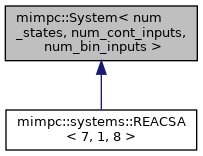#include <System.hpp>

Public Member Functions | |
| virtual AMatrix | getA (const StateVec &state) const =0 |
| virtual BMatrix | getB (const StateVec &state) const =0 |
| virtual void | updateA (const StateVec &state, std::function< void(unsigned int, unsigned int, double)> &changeAval) const =0 |
| virtual void | updateB (const StateVec &state, std::function< void(unsigned int, unsigned int, double)> &changeBval) const =0 |
Detailed Description
template<int num_states, int num_cont_inputs, int num_bin_inputs>
class mimpc::System< num_states, num_cont_inputs, num_bin_inputs >
In this library the system Dynamics are represented as \( \mathbf{\dot{x}} = \mathbf{A} \mathbf{x} + \mathbf{B} \mathbf{u} \), where
- system dynamics \(\mathbf{A}\)
- input dynamics \(\mathbf{B}\)
- system state is \(\mathbf{x} \in \mathbb{R}^{\text{num_states}}\)
- system input consists of a continuous and binary part \(\mathbf{u} = \left[\mathbf{u}_\text{cont}^T,\mathbf{u}^T_\text{bin}\right]^T\), \(\mathbf{u}_\text{cont} \in \mathbb{R}^{\text{num_cont_inputs}}\) and \(\mathbf{u}_\text{cont} \in \left\{0,1\right\}^{\text{num_bin_inputs}}\)
This class represents the system dynamics by offering functions that return the matrices \(A,B\) in order to allow a state dependend linearization. When the MPC needs to know the system state, it will call the functions getA() or getB() to retrieve the full state matrix based on the current state. In order to avoid computational overhead when the systems state has changed the functions updateA() or updateB() are used in order to retrieve only the matrix values that change due to linearization.
To define the dynamics of a system, this abstract class has to be by a class which returns the linearized system dynamics as specified. The (SCIPSolver) or (MPC) can than be instantiated with the system dynamics as a template argument.
- Template Parameters
-
num_states Number of system states num_cont_inputs Number of continuous inputs num_bin_inputs Number of binary inputs
Member Function Documentation
◆ getA()
|
pure virtual |
Linearizes and returns the system dynamics as matrix A
- Parameters
-
state state to linearize the system around
- Returns
- system matrix A
Implemented in mimpc::systems::REACSA.
◆ getB()
|
pure virtual |
Linearizes and returns the system input dynamics as a matrix B
- Parameters
-
state state to linearize the system around
- Returns
- input matrix B
Implemented in mimpc::systems::REACSA.
◆ updateA()
|
pure virtual |
Updates the states of the linearized system matrix A based on a new state
- Parameters
-
state state to linearize the system around changeAval callback function that will called for each matrix element which changes due to linearization around the new state. The callback function will be called with parameters (row index, column index, value). The values that are not updated are assumed to stay as returned by getA()
Implemented in mimpc::systems::REACSA.
◆ updateB()
|
pure virtual |
Updates the states of the linearized system matrix B based on a new state
- Parameters
-
state state to linearize the system around changeAval callback function that will called for each matrix element which changes due to linearization around the new state. The callback function will be called with parameter (row index, column index, value). The values that are not updated are assumed to stay as returned by getB()
Implemented in mimpc::systems::REACSA.
The documentation for this class was generated from the following file:
- include/System.hpp